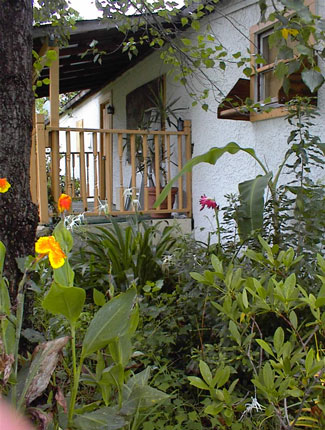The Association Between Termites and Landscaping
By Chris Williams on November 5, 2014.

Trimming or removing thick vegetation around your home can help prevent termites.
Certain conditions around the foundation of a home such as moisture, heavy mulch, and dense vegetation attract pests. Some pests such as millipedes, sow bugs, crickets, and earwigs thrive in damp places with decaying vegetation. In these situations, we direct customers to clean up and simplify conditions around the perimeter of their homes to keep from attracting pests (see Landscaping with Pests in Mind – Advice From the Pros).
Subterranean termites are just one of the pests (but maybe the most serious) that can be attracted to a home because of the landscaping. There are steps you can take around your yard to eliminate or reduce termites’ access to moisture, food, and shelter.
Remove Scrap Wood, Fallen Branches, and Heavy Mulch
All of these are made up of cellulose which is food for termites. Other sources of cellulose are rotting stumps, dead trees, old firewood, and wood scraps such as form boards or grade stakes in the crawlspace or under the porch. Keep firewood piles at least 20 feet from your home.
Keep mulch away from the foundation; use only a thin layer of hardwood or bark mulch, or substitute an inorganic (non-wood) mulch such as gravel (see Mulch and Pests – Advice From the Pros). Don’t let any wood that is in contact with the ground touch any part of your house; that creates a termite highway. Planter boxes are often built with no bottom and using the house as a fourth side, or they are touching a deck or porch that touches the house.
Reduce Moisture Around the Foundation
Soft-bodied termites live in the soil because they require a high moisture level. When soil or mulch around the foundation of your home is constantly wet, termites thrive. Make sure that downspouts and splash blocks drain away from the home, that outside spigots are not dripping, and that there are no low spots that hold water. Soil erosion or flooding around a home can destroy any soil treatment barrier that is in place.
Train, Trim, or Remove Thick Vegetation
Thick groundcover plants and other heavy vegetation at the foundation wall trap moisture next to the foundation and can provide termites with protected and hidden access to the house. If foundation shrubs or other plants are touching the house, termites can make mud tubes up the plants and into the house.
WARNING: When your home has a traditional termite treatment, pesticide is injected into the soil around the foundation to form a barrier that keeps termites from reaching your home. If properly done, this treated zone can protect your home for many years…unless it is disturbed by new landscaping or re-grading. Digging around the foundation to install cable, hoses, or plants will likely destroy portions of the treated soil, Any new soil added around the foundation will not be treated unless you have an exterminator do so. For major foundation disturbance, you may need to have your home retreated for termites by a professional.
Installation of termite bait monitors in the soil around your home is one way to get termite protection without having to disturb the area around the foundation. See Termite Bait Stations Protect Landscaping for more information.
Photo credit: leita_ / Foter / CC BY-ND
Sign up for our biweekly email newsletter for more information about bugs and pests!